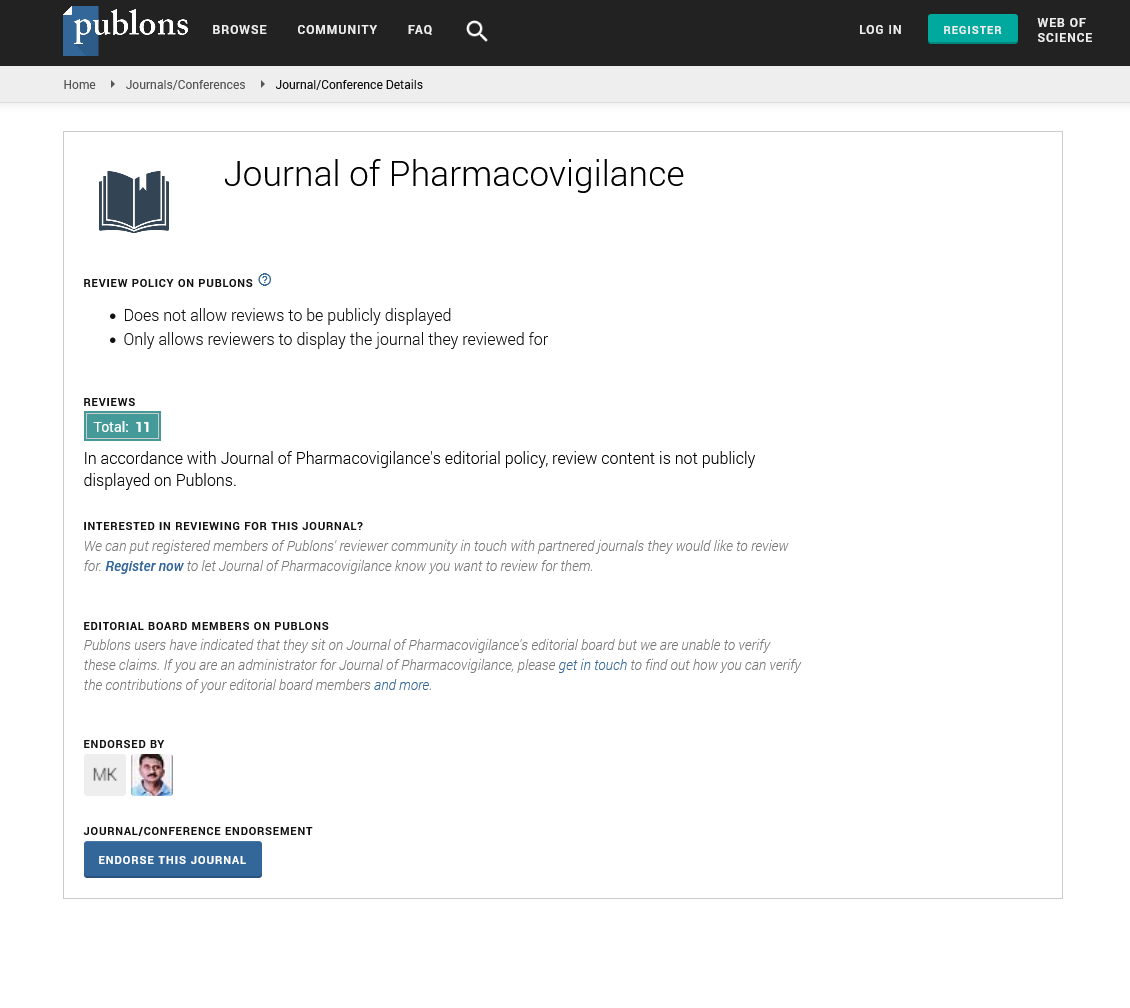Indexed In
- Open J Gate
- JournalTOCs
- The Global Impact Factor (GIF)
- RefSeek
- Hamdard University
- EBSCO A-Z
- OCLC- WorldCat
- Publons
- Euro Pub
- Google Scholar
Useful Links
Share This Page
Journal Flyer

Open Access Journals
- Agri and Aquaculture
- Biochemistry
- Bioinformatics & Systems Biology
- Business & Management
- Chemistry
- Clinical Sciences
- Engineering
- Food & Nutrition
- General Science
- Genetics & Molecular Biology
- Immunology & Microbiology
- Medical Sciences
- Neuroscience & Psychology
- Nursing & Health Care
- Pharmaceutical Sciences
Commentary - (2024) Volume 12, Issue 2
Utilization of Electronic Health Records for Active Pharmacovigilance Surveillance
Fukami Mai*Received: 29-May-2024, Manuscript No. JP-24-25985; Editor assigned: 31-May-2024, Pre QC No. JP-24-25985 (PQ); Reviewed: 14-Jun-2024, QC No. JP-24-25985; Revised: 21-Jun-2024, Manuscript No. JP-24-25985 (R); Published: 28-Jun-2024, DOI: 10.35248/2329-6887.24.12.478
About the Study
Pharmacovigilance (PV) is essential for ensuring medication safety by monitoring Adverse Drug Reactions (ADRs). Traditional, passive reporting systems have limitations. Electronic Health Records (EHRs) offer data source for active PV surveillance, enabling proactive identification of potential ADRs. This manuscript explores the advantages and challenges of utilizing EHRs for active PV, discussing methods for data extraction, analysis, and signal detection. We address ethical considerations and data security concerns, proposing future directions to optimize EHR utilization in active PV and bolster medication safety.
Safe and effective medications are fundamental to healthcare. However, all medications carry the potential for adverse effects. Pharmacovigilance (PV) is the science and activities concerned with the detection, assessment, understanding, and prevention of Adverse Drug Reactions (ADRs). Traditionally, PV relies on passive reporting systems, where healthcare professionals voluntarily report suspected ADRs. While valuable in identifying major safety concerns, passive reporting suffers from underreporting, delayed reporting, and difficulty establishing causality.
Electronic Health Records (EHRs) have emerged as a transformative tool for active pharmacovigilance surveillance. EHRs house a vast amount of patient data, including demographics, diagnoses, medications, laboratory results, and clinical notes. This rich data source allows for proactive identification of potential ADRs through various methods, including data mining and signal detection algorithms.
Identifying pre-defined terms or phrases within clinical notes suggestive of potential ADRs (e.g., "rash," "dizziness," "increased liver enzymes"). Utilizing algorithms to uncover hidden patterns and associations within the EHR data, potentially leading to the discovery of novel ADRs. Analyzing predefined drug-adverse event combinations to identify statistically significant increases in co-occurrences.
Employing machine learning models trained on existing ADR data to automatically flag potential cases in EHRs. EHRs enable the proactive identification of potential ADRs, facilitating earlier detection and intervention. Compared to passive reporting systems, EHR data captures a more comprehensive picture of medication use and patient outcomes. EHR data can be accessed and analyzed in real-time, enabling faster detection and response to potential safety signals. EHR-based systems can be easily scaled to analyze large patient populations, providing a broader understanding of medication safety.
The quality and standardization of data within EHRs can vary significantly, potentially impacting the accuracy of analysis. Ensuring patient data privacy and security is significant when utilizing EHRs for research purposes. Machine learning algorithms used for analysis can be biased based on the training data, potentially leading to false positives or negatives. While EHR data can identify potential associations, establishing causal relationships between medications and adverse events often requires further investigation. Patients should be informed about how their EHR data will be used for PV activities and have the option to opt-out.
Patient data used for analysis should be anonymized to protect privacy. The methods used for data analysis and signal detection should be transparent and accountable to regulatory bodies. Standardizing EHR data formats and terminologies will facilitate more efficient and reliable analysis across different healthcare systems. Integrating EHR data with other sources of real-world data, such as pharmacy claims databases, can provide a more holistic view of medication use and safety. Utilizing advanced analytics techniques, including natural language processing and deep learning, can further improve the accuracy and efficiency of signal detection within EHRs.
Conclusion
Electronic health records offer a tool for active pharmacovigilance surveillance. By leveraging EHR data through various methods and addressing the associated challenges, we can enhance the identification and management of ADRs, ultimately improving medication safety for all patients.
Citation: Mai F (2024) Utilization of Electronic Health Records for Active Pharmacovigilance Surveillance. J Pharmacovigil. 12:478.
Copyright: © 2024 Mai F. This is an open-access article distributed under the terms of the Creative Commons Attribution License, which permits unrestricted use, distribution, and reproduction in any medium, provided the original author and source are credited.

